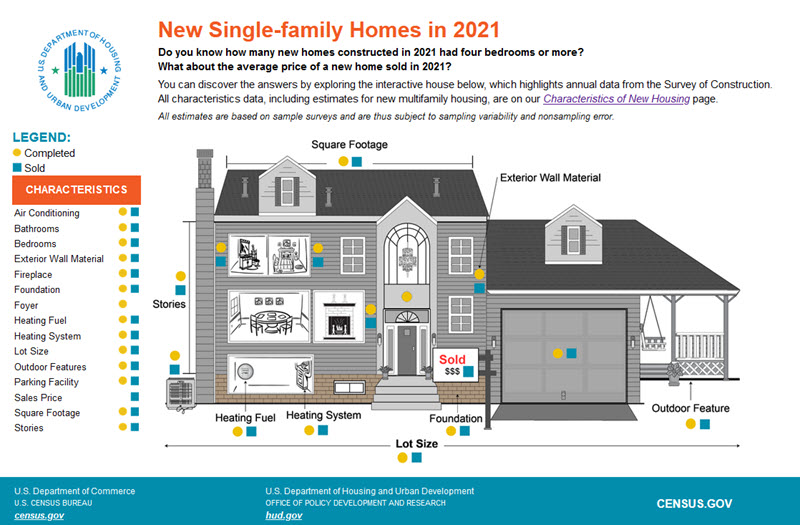Highlighting Census Bureau Data on Housing and Construction During American Housing Month, National Homeownership Month
Two housing celebrations this month provide an opportunity to explore the nation's housing landscape through an economic and lifestyle lens, from the number of homes built to who is struggling to pay for housing and how many homes have more than three bedrooms or bathrooms.
American Housing Month and National Homeownership Month celebrate the value of homeownership to families and communities and the ways banks and other public and private institutions can help people reach their housing goals.
And the U.S. Census Bureau provides the data needed to build a complete picture of housing activity in the United States.
For example, the latest Census Bureau numbers show that prices of new homes are rising (average sale price has topped $500,000), housing vacancies are at or near historic lows and most new single-family homes completed had at least 3 bedrooms (877,000 of the total 970,000 new single-family homes completed).
The average sales price was $570,300 in April 2022, an increase from $434,800 (31.2%) in April 2021.
What New Homes Look Like
The Census Bureau’s Characteristics of New Housing provides national and regional annual data on the characteristics of new privately-owned residential structures.
It includes square footage, number of bedrooms and bathrooms, type of wall material, sales prices, and even the type of fuel used to heat the home.
Of the 970,000 single-family homes completed in 2021:
- 927,000 had air-conditioning.
- 93,000 had two bedrooms or less and 444,000 had four bedrooms or more.
- 27,000 had one and one-half bathrooms or less and 320,000 homes had three or more bathrooms.
- 369,000 had a heat pump. Of these, 361,000 were air-source and 8,000 were ground-source.
- 895,000 were framed in wood and 71,000 were framed using concrete.
- 330,000 had a patio and a porch, while 87,000 had no outdoor features.
Full House
The Housing Vacancies and Homeownership economic indicators data provide current information on the rental and homeowner vacancy rates and characteristics of available housing. It shows:
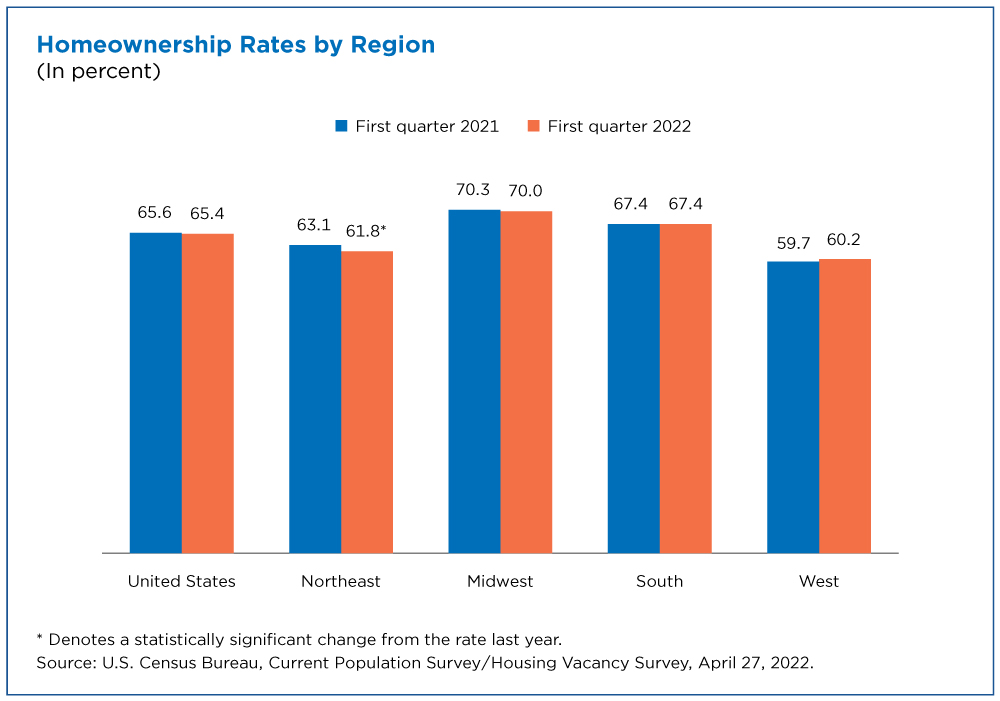
The first quarter 2022 homeownership rate was highest in the Midwest (70.0%), followed by the South (67.4%), Northeast (61.8%) and West (60.2%).
The homeownership rate in the Northeast was lower than the first quarter 2021 rate, while rates in all other regions were not statistically different from the first quarter 2021 rates.
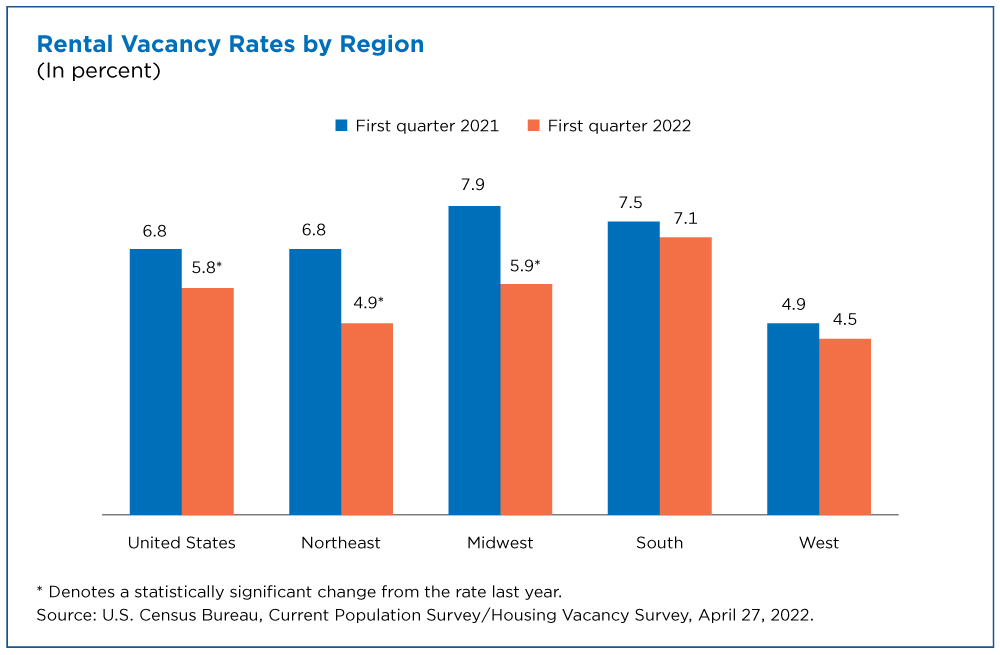
The rental vacancy rate in the South (7.1%) was higher than the rate in the Midwest (5.9%), and both were higher than the rates in the Northeast (4.9%) and West (4.5%).
However, the rental vacancy rate in the Northeast was not statistically different from the West. The rates in the Northeast and Midwest were lower than their first quarter 2021 rates. The rates in the South and West were not statistically different from the first quarter 2021 rates.
Housing Cost and Condition
The American Housing Survey provides up-to-date information about housing conditions and cost of housing in the United States and major metropolitan areas. The most recent data is for 2019 and includes:
- Physical condition of homes and neighborhoods. Of the 124 million occupied households in the United States:
- 14.8 million saw signs of mice/rats inside the home in the last 12 months.
- 11.7 million reported water leakage from outside the home.
- 9.4 million reported water leakage from inside the home.
- Costs of financing and maintaining homes. Owners spent a median of $4,400 on improvements to their homes such as (median expenditures for selected projects):
- HVAC: $4,000.
- Kitchen remodels: $6,000.
- Flooring/paneling/ceiling tiles: $2,000.
- Characteristics of people who live in the homes, including those who need accessible homes the most:
- 48 million households (39%) have at least one person age 65 and over, one person(s) with a disability, or both.
- About 1 in 8 households have a household member who uses a mobility device for a long-term condition.
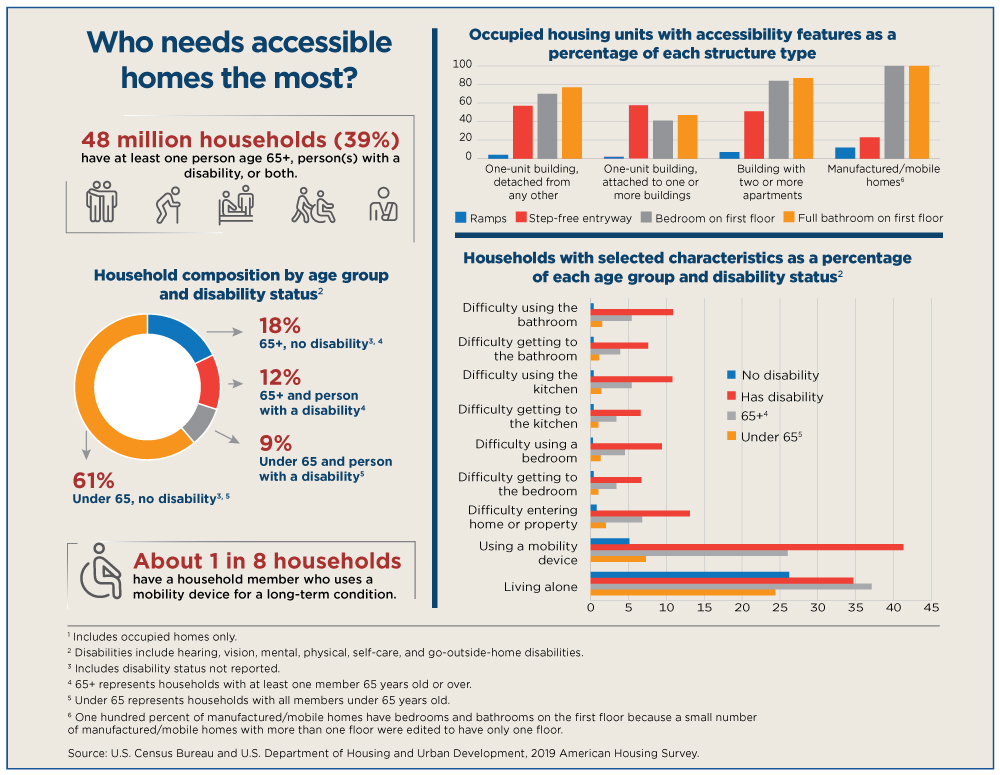
The AHS Table Creator allows for data access to selected state and metro areas.
New Home Sales
The New Residential Sales (NRS) economic indicator includes estimates of new homes sold, median and average sales prices, median months for sale since completion, months’ supply, and inventories of homes built for sale.
Sales of new single‐family houses in April 2022 were at a seasonally adjusted annual rate of 591,000.
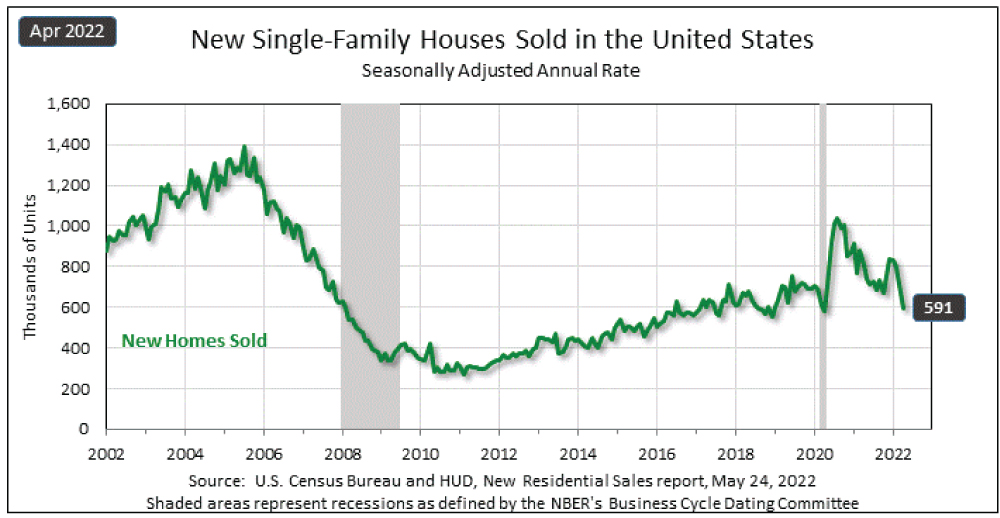
This is 16.6% (±10.4 %) below the revised March rate of 709,000 and is 26.9% (±13.7%) below the April 2021 estimate of 809,000.
The average sales price was $570,300 in April 2022, an increase from $434,800 (31.2%) in April 2021.
New Housing Construction
The New Residential Construction (NRC) economic indicator provides monthly estimates of starts, completions and inventories of single-family and multifamily structures. The inventories include projects that are authorized but not yet started, as well as projects that are currently under construction.
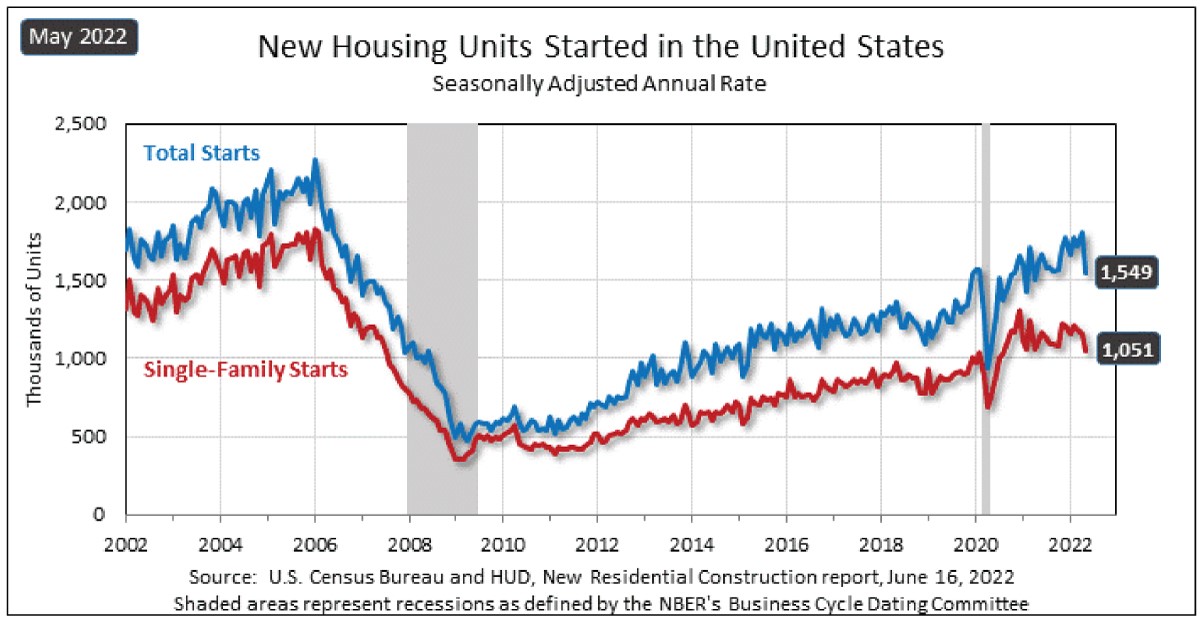
For example, the May 2022 release shows that privately‐owned housing starts in May were at a seasonally adjusted annual rate of 1,549,000. This is 14.4 % (±8.9 %) below the revised April estimate of 1,810,000 and is 3.5 % (±10.7 %) below the May 2021 rate of 1,605,000.
Single‐family housing starts in May were at a rate of 1,051,000; this is 9.2 % (±11.0 %) below the revised April figure of 1,157,000. The May rate for units in buildings with five units or more was 469,000.
Building Materials and Furnishings
Industries that manufacture all the materials you need to build and furnish a home — from windows and doors to kitchen appliances — employ thousands and generate billions of dollars in revenue.
The U.S. Census Bureau has released an interactive visualization showing the value of shipments and employment for select manufacturing industries that produce housing-related products like paint, upholstered chairs, kitchen cabinets and other materials that make a home from the Annual Survey of Manufactures (ASM) data. Simply hover over the “dots” to find the value of shipments and employment data.
Note: The original visualization in this story has since been removed. Use the links below to view Housing-Related Manufacturing in America with more recent data from the Annual Survey of Manufacturers.
-
VisualizationHousing-Related Manufacturing in America: 2019 and 2020June 15, 2022This data visualization explores the value of shipments and employment for select housing-related manufacturing industries.
-
VisualizationHousing-Related Manufacturing in America: 2020 and 2021May 09, 2023This data visualization explores the value of shipments and employment for select housing-related manufacturing industries.
Building Permits
One of the data sources of the NRC is the Building Permits Survey which provides the number and valuation of units authorized by building permits.
The data are released monthly and annually for the U.S. total, four census regions, nine census divisions, metropolitan areas, states and counties, and for select individual jurisdictions.
Pennsylvania had the largest percent change in new privately-owned housing units that were authorized for construction in 2020-2021, followed by New Mexico and Colorado.
This map shows the change by state:
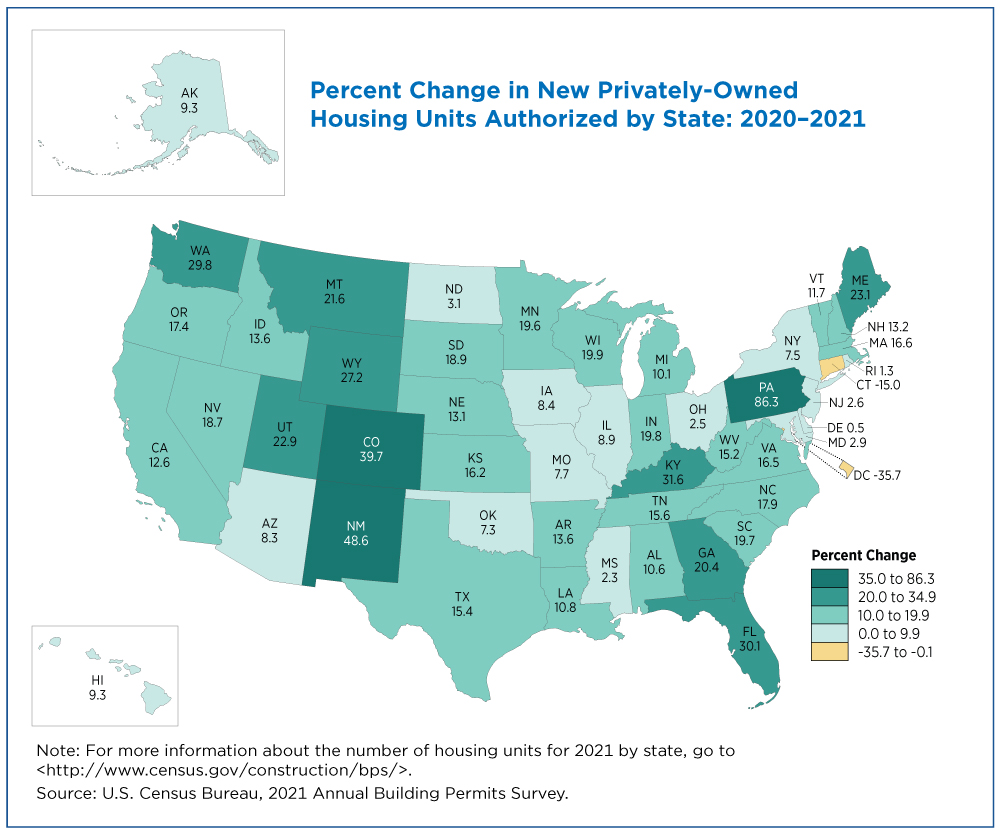
The Building Permits Survey Data Visualization provides easy access to current data.
The Census Bureau is exploring significant innovations to improve our New Residential Construction and our Building Permit data through satellite imaging, artificial intelligence, new data sources, and new methodology with the potential to replace survey collection methods that date back to the 1950s.
Find out more from the Census Bureau Construction Data: From Stone Age to Space Age article.
Housing Impact
The impact of the housing and construction industries is far-reaching. It extends to industries that manufacture, distribute and purchase building materials, home furnishings, appliances and other related products.
It also has an impact on the services industry, including real estate, insurance agents and brokers, finance, repair and maintenance, consumer goods rental, and more.
Stats for Stories has a complete list of all the housing-related data available from the Census Bureau.
The Exploring Census Data: Construction webinar presented on June 16, 2022, will provide even more information.
Note
Differences between estimates may be attributed to sampling or nonsampling error, rather than to differences in underlying economic conditions. Caution should be used in drawing conclusions from the estimates and comparisons shown.
Phil Thompson is the special projects and outreach coordinator in the Census Bureau’s Economic Management Division.
Related Statistics
-
Stats for StoriesAmerican Housing Month: June 2023The 2021 American Community Survey counted 142.15M housing units, up 3.61M from 2018, and up 10.36M from 131.79M in 2010.
-
Housing Vacancies and Homeownership (CPS/HVS)Provides current information on the rental and homeowner vacancy rates, and characteristics of units available for occupancy.
-
American Housing Survey (AHS)The AHS is sponsored by the Department of Housing and Urban Development (HUD) and conducted by the U.S. Census Bureau.
Subscribe
Our email newsletter is sent out on the day we publish a story. Get an alert directly in your inbox to read, share and blog about our newest stories.
Contact our Public Information Office for media inquiries or interviews.
-
America Counts StoryHousing Vacancy Rates Near Historic LowsMay 12, 2022Housing Vacancy Survey shows that availability of homeowner and rental housing tightened during the COVID-19 pandemic.
-
America Counts StoryCensus Bureau Construction Data: From Stone Age to Space AgeFebruary 08, 2022The U.S. Census Bureau is phasing in improvements, including satellite imaging, to improve construction data products that are key federal economic indicators.
-
America Counts StoryU.S. Housing Vacancy Rate Declined in Past DecadeAugust 12, 2021The percentage of housing units vacant in 2020 dropped to 9.7% from 11.4% in 2010, according to 2020 Census data released this week.
-
America Counts StoryHousing Growth Highest in Urban Cores of Fast-Growing MetrosNovember 02, 2021The 2020 Census shows the nation’s housing stock increased from 2010 to 2020 but growth was uneven across the country.
-
EmploymentThe Stories Behind Census Numbers in 2025December 22, 2025A year-end review of America Counts stories on everything from families and housing to business and income.
-
Families and Living ArrangementsMore First-Time Moms Live With an Unmarried PartnerDecember 16, 2025About a quarter of all first-time mothers were cohabiting at the time of childbirth in the early 2020s. College-educated moms were more likely to be married.
-
Business and EconomyState Governments Parlay Sports Betting Into Tax WindfallDecember 10, 2025Total state-level sports betting tax revenues has increased 382% since the third quarter of 2021, when data collection began.
-
EmploymentU.S. Workforce is Aging, Especially in Some FirmsDecember 02, 2025Firms in sectors like utilities and manufacturing and states like Maine are more likely to have a high share of workers over age 55.

